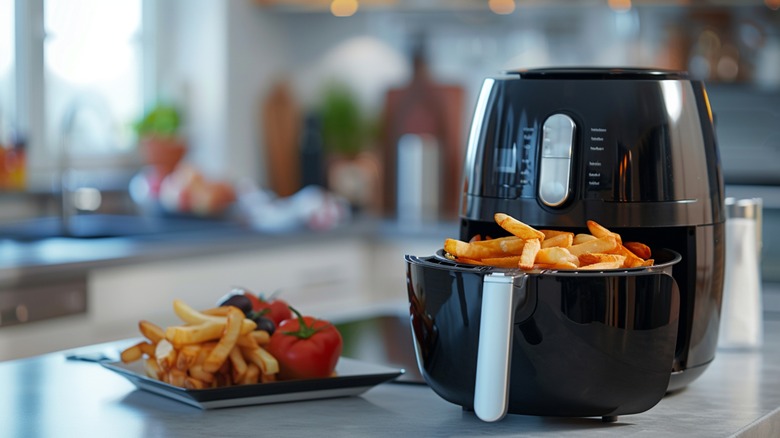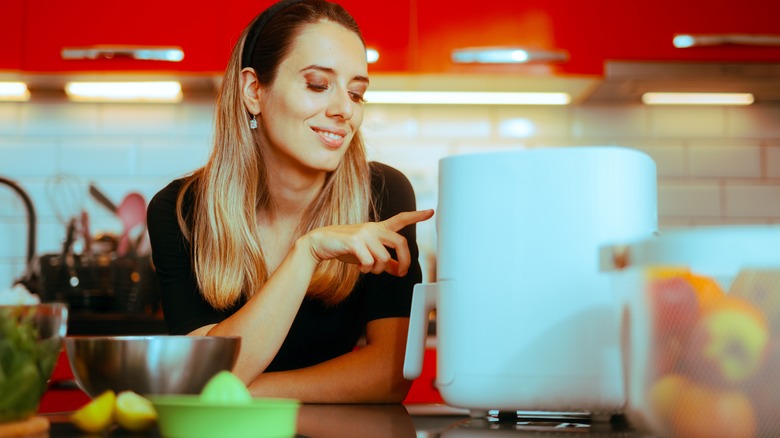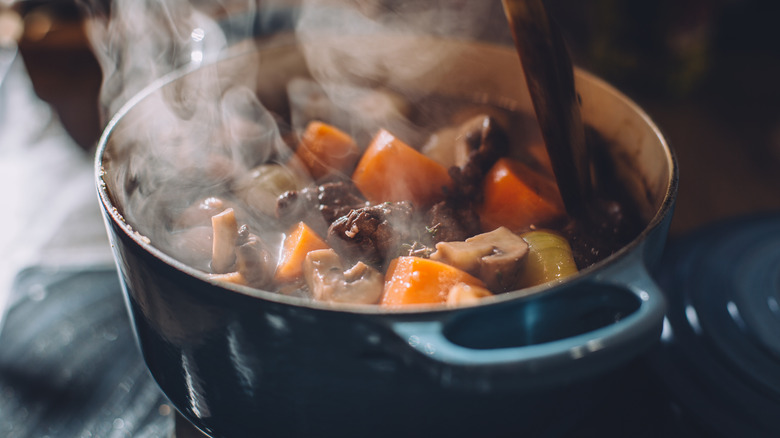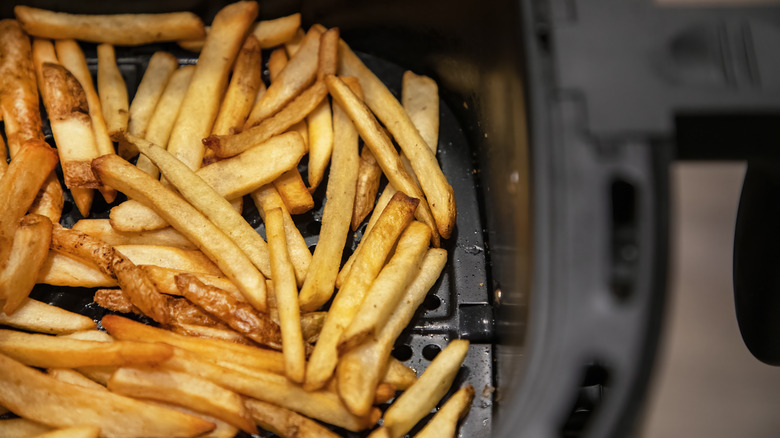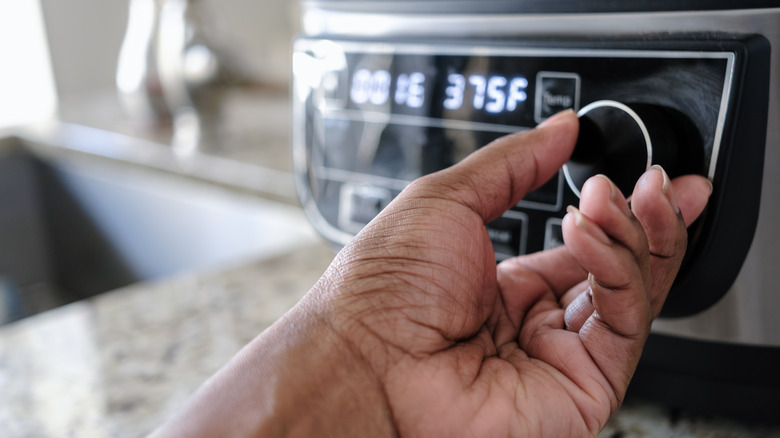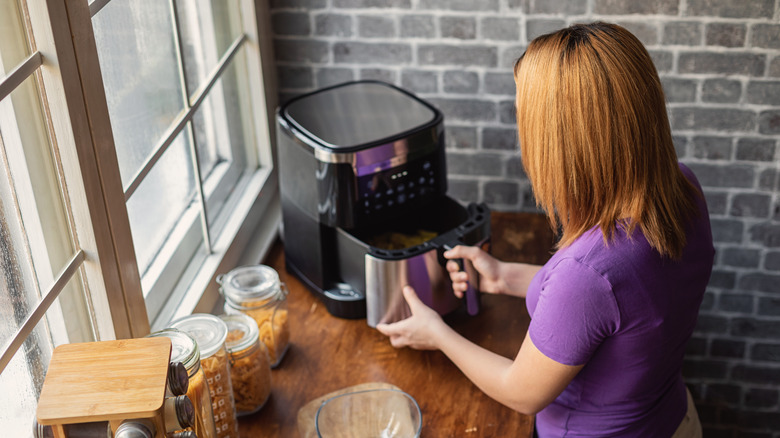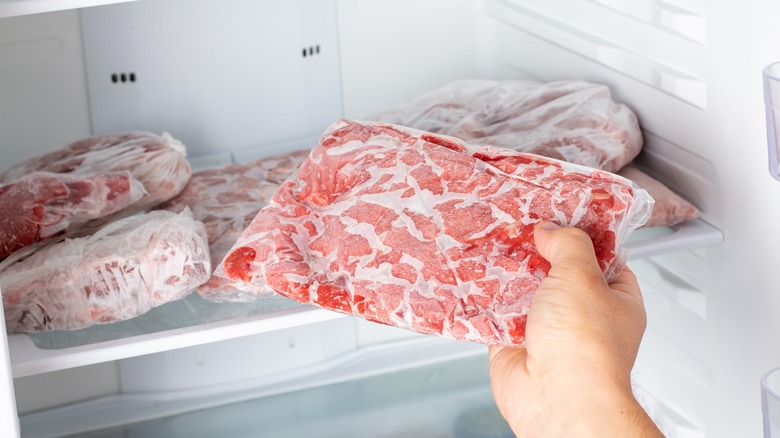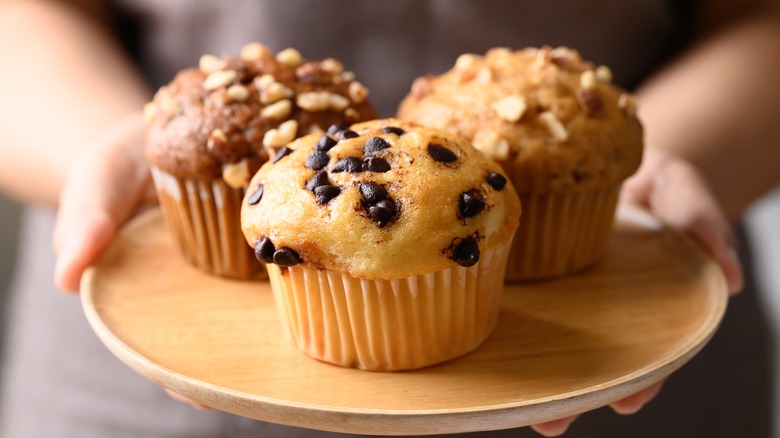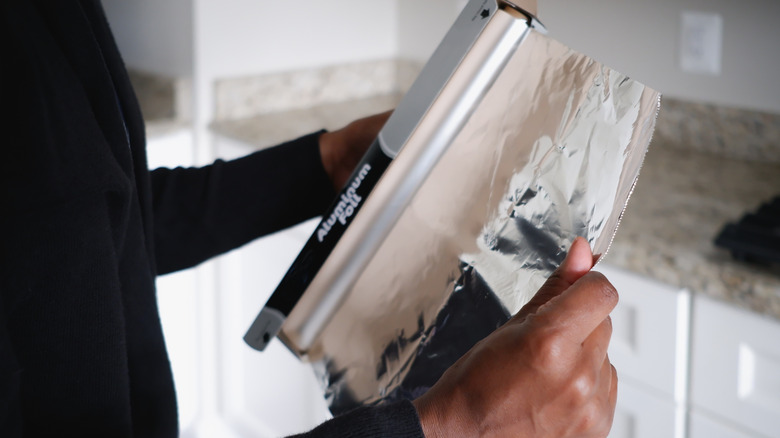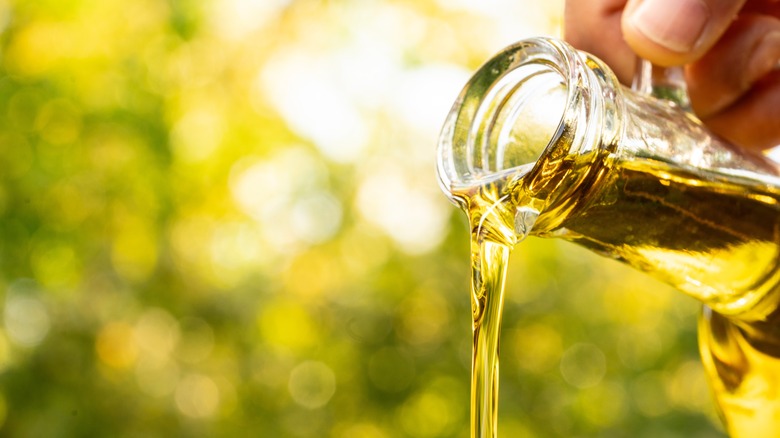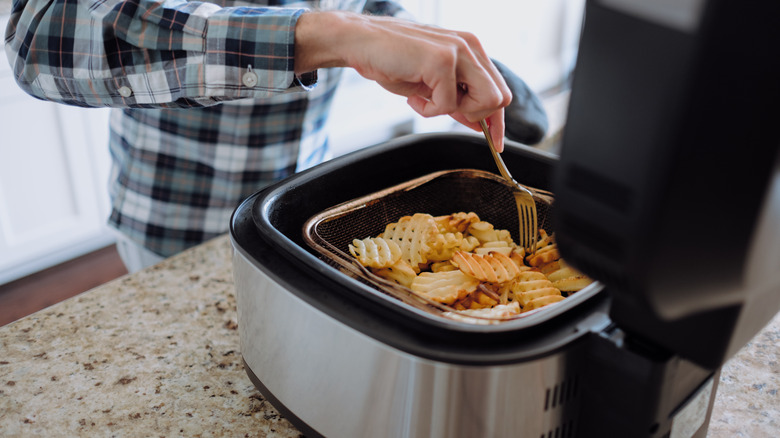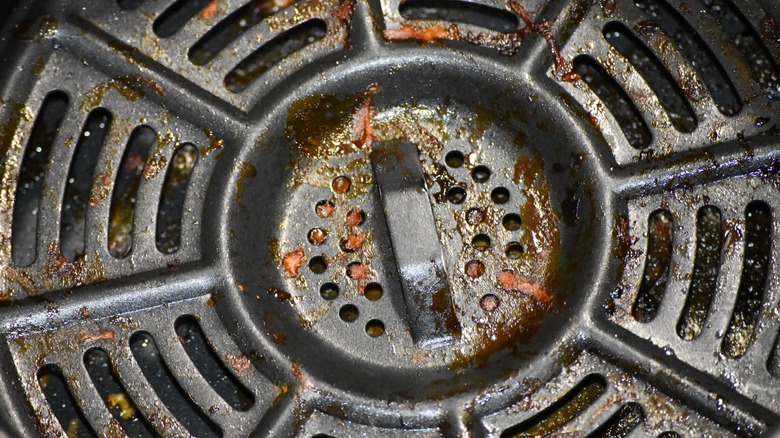11 Mistakes You're Making When Reheating Foods In The Air Fryer
We may receive a commission on purchases made from links.
An air fryer works like a mini convection oven. At its most basic, the appliance features a fast-acting electric heating element, which heats up the air inside the device. A fan then circulates the hot air around the food, giving it a crispy outer layer normally associated with frying. The food is usually placed in a perforated cooking basket, which lets any excess grease drain away from the cooking area.
Air fryers are great for meal prep, provided you know how to use them. They don't just reduce cooking time but also allow you to cook multiple ingredients with minimal oil. Air fryers are also energy efficient, heating up faster and using less energy than conventional ovens or deep-fryers. This is precisely what makes them ideal for reheating leftovers. Not only are they fast, but if used properly, they will leave your food delicious and crispy rather than soggy like a microwave.
Ready to take your air fryer game to the next level? Take a look at our roundup of the most common reheating mistakes and how to avoid them.
Failing to preheat the air fryer
Just as you would preheat an oven to the perfect temperature before cooking, it's important to preheat an air fryer before reheating certain foods. Not doing this could lead to unevenly cooked or soggy fare. Bringing the air fryer to the right temperature before popping your food into the appliance is particularly important for dishes that require a good sear, such as burger patties, or a crispy exterior like french fries or fried chicken. To preheat an air fryer, simply set it to the desired temperature with the basked inside and wait a few minutes.
It's important to remember that while some foods benefit from intense heat, this isn't true for more delicate products that are better suited to slower reheating. For instance, placing shrimp in an air fryer that's been preheated could dry them out or burn them. In addition, it's important to remember that you don't need to preheat the air fryer for foods that require prolonged cooking time, like whole chicken or baked potatoes.
Reheating foods that aren't air fryer friendly
Air fryers are an incredible invention that allows for faster and healthier cooking with little to no oil. That said, reheating certain foods in the appliance is a big no-no. While items such as pizza, chicken wings, and fish filets lend themselves perfectly to this cooking method, reheating some other items in an air-fryer could lead to disastrous results.
To cut a long story short, reheating certain foods in an air fryer could ruin their texture and flavor or create a mess in the frying basket. While these aren't items you'd typically reheat, most people know that putting leafy greens like spinach or lettuce in an air fryer is likely to overcook and burn them. Similarly, dishes with creamy sauces and cheesy items are better reheated in an oven or on the stovetop, as they can leave a sticky residue inside the appliance.
While it's possible to reheat liquid-based dishes such as stews and soups in an air fryer, it's much simpler and faster to heat them up on a stovetop. Some other common foods that shouldn't be reheated in an air fryer include rice and pasta since the hot air that circulates inside the device is likely to dry them out.
Placing too much food in the air fryer basket
As tempting as this may be, overcrowding your air fryer basket with food can lead to uneven reheating. This is because air fryers work by circulating hot air around the food, and filling the basket with too much food impedes this airflow. This, in turn, can stop the browning process and create steam, leaving your french fries and chicken wings soggy instead of crispy. In short, if you are aiming for an evenly warmed-up meal, it's better to reheat food in batches rather than pile everything in at once and risk substandard results. For best results, be sure to follow the manufacturer's instructions on how much food your air fryer can handle.
If you have a large family or often find yourself cooking for groups, it's better to invest in a larger air fryer that can handle bigger batches of food. As a rule of thumb, a 2 or 3-quart air fryer should be spacious enough for reheating meals for one or two people. It's a good idea to increase the fryer capacity by an extra quart for each additional person. That said, it's also important to note that a larger air fryer will take longer to heat up and reheat the food than a smaller unit.
Reheating food at an overly high temperature
Just like setting the air fryer to an overly low temperature isn't going to reheat your food to the right temperature, warming up food at an overly high temperature can ruin it. In a nutshell, when the heat is too intense, the outside of the food is likely to dry out or even burn, while the inside may remain cold.
Setting the air fryer to the same temperature as you would an oven could actually result in overcooking the food rather than reheating it. This is because the cooking times are also normally shorter in an air fryer than in an oven. According to the USDA, most foods should be air-fried at between 350 and 400 degrees Fahrenheit for between five and 25 minutes.
While there are no hard and fast rules about what temperatures to use when reheating food, chef Poppy O'Toole, author of "The Actually Delicious Air Fryer Cookbook," recommends evaluating the power of your air fryer with the chip test — that would be french fries, for American readers. "I found it useful to start off with frozen products, like chips. Put them in and keep an eye — if they cook in five minutes, you know you've got a very strong air fryer. Then you can start working out how best to cook other dishes," she said in an interview with the BBC.
Not flipping or shaking the food during reheating
When it comes to ensuring that your food is reheated evenly, an air fryer isn't all that different from a skillet or grill. Just as with these other cooking methods, moving the food around during the reheating process can help avoid cold spots. The best way to do this is by either flipping the food or shaking the air fryer basket.
In most air fryers, the heating element is located on top of the appliance, meaning that the parts of the food touching the basket don't get as much exposure to the hot air. Even if the food is layered perfectly in the compartment, if you don't toss it around at some stage, it may become overly dry or even burn on one side. Alternatively, it may not reheat all the way through or stick to the bottom of the basket.
If you only have the time to flip or shake the food once, it's best to do so midway through the reheating cycle. Some air fryers can be set to beep halfway through cooking, signaling that it's time to flip or toss your food. For optimal results, use tongs to turn larger items like chicken breast and shake the basket if you're reheating smaller items like frozen vegetables. To shake it, simply slide the basket out of the appliance and gently shake it over the kitchen sink.
Thinking that you need to thaw all food before reheating
If you think that you need to thaw frozen food before reheating it in the air fryer, you are in for a pleasant surprise. Since the air fryer has been designed to handle frozen food, thawing it before starting the reheating process is usually a waste of time. In fact, air fryers are ideal for reheating frozen protein like poultry, salmon, pork chops, and sausages. Another great piece of news is that reheating frozen food in the air fryer takes approximately the same time as it would to warm it up from thawed on the stove or in a regular oven.
When it comes to some foods, thawing them before popping them in the air fryer can be counterproductive. For instance, defrosting french fries before placing them in the air fryer can make them soggy. Reheating french fries directly from frozen is likely to garner much better results, making them crispy and delicious on the outside and soft and fluffy on the inside.
There are a few tricks for reheating pre-packaged frozen food in an air fryer. Firstly, it's best to reduce the cooking oven temperature listed on the packaging by around 50 degrees Fahrenheit. Next, it's crucial to remove any store-bought frozen meals from the plastic container since it can catch fire or even release harmful chemicals into the food. This also applies to containers labeled microwave- or oven-safe.
Reheating some items without adding moisture to the air fryer
Despite being extremely convenient, air fryers can sometimes dry out food. After all, there is a good reason why they are sometimes used to dehydrate fruit and vegetables like apricots, apples, mushrooms, and peppers. This is for the simple reason that air fryers work by circulating hot air at high speeds, which removes moisture from food.
While this doesn't apply to all food types, some items prone to drying out — like pastries and muffins — may benefit from extra moisture if you want to warm them up. One way to achieve this is by placing a small amount of water on the tray beneath the air fryer basket. The resulting steam will help to keep the air fryer basket moist, lowering the likelihood of the food becoming dry. This method is also effective for preserving moisture in vegetables by gently steaming them.
Adding a small amount of water underneath the basket of an air fryer can also reduce smoke when reheating greasy foods like sausages or bacon. This is because the water will trap the grease that drips from the food, preventing it from burning and keeping your kitchen smoke-free. This can make a world of difference, particularly for those who have an ultra-sensitive smoke alarm.
Not being careful when using aluminum foil to reheat your food
Temperature-resistant, lightweight, and nonstick, aluminum foil has earned its rightful place in the kitchen. From storing leftovers to grilling, roasting, and baking, this flexible tool is a real multitasker. Unfortunately, aluminum foil and air fryers are not always an ideal mix.
The main concern is that the foil may flap around inside the appliance if not properly secured. In air fryers where the heating element is located at the top of the device, loose aluminum foil can be lifted by the circulating airflow, touching and damaging the element. If the heating element happens to be located below the frying basket, it can impede the appliance's air circulation, preventing it from reheating evenly.
So, what's the solution? You can still use aluminum foil in an air fryer to minimize cleanup, provided you follow a few simple guidelines. First, always weigh the foil down with enough food to keep it securely in place. Second, cut the foil down to size to ensure that there is enough room around it to let air circulate. Finally, never place acidic foods, such as tomatoes or citrus fruit, directly on aluminum foil. This is because the acids can break down the foil, releasing aluminum into the food.
Using too much or not enough cooking oil
One of the main advantages of air fryers is that they don't require as much cooking oil as traditional frying methods, resulting in healthier cooking. Instead of submerging the food in sizzling oil, air fryers achieve the same result by circulating hot air around oil-free or lightly oiled food. Reheating some foods in the air fryer doesn't require any oil — frozen french fries, spring rolls, and chicken nuggets fall into this category. Conversely, throwing a teaspoon of grease into the mix can go a long way in giving some leftovers, such as roasted veggies, a crispy exterior.
Air fryers don't have a special compartment for oil. Instead, oil is applied directly on the food with a cooking brush or a refillable kitchen spray bottle. Only coat the food items with one layer of oil, otherwise your food may turn out overly soggy. In addition, not every oil is suitable for use in an air fryer. To prevent it from burning, use cooking oil with a high smoke point. Avoid oils like extra virgin olive oil and vegetable oil, since they have low smoke points, instead opting for high-smoke point options such as avocado oil and canola oil. It's also best to avoid oil sprays in cans since they can contain aerosol agents that can degrade the nonstick surface of the appliance's basket.
Reheating the food for too long or not long enough
Even if you reheat your food at the right temperature, removing it from the air fryer too soon or leaving it in the fryer basket for too long isn't going to yield the results you are after. While the recommended temperature for reheating meats, french fries, and other fried foods in an air fryer is 350 degrees Fahrenheit, the food isn't going to have the desired flavor and crispiness if you don't strike the right balance between temperature and time. If you remove the food too early, it might feel warm on the outside but still be cold on the inside. Conversely, food that's left in the air fryer for too long is likely to become overcooked, too dry, or even burn.
To get the timing right, the first rule is to remember that food reheats faster in an air fryer than in a conventional oven. For instance, french fries, fried chicken, and grilled veggies should only take between three and five minutes at 350 degrees Fahrenheit. Meanwhile, warming up casseroles might take up to 10 minutes at the same temperature. However, since these are only guidelines, it's important to periodically check your food for doneness. Luckily, you can open the air fryer at any moment of the cooking cycle to check on the progress of your food.
Not cleaning the air fryer after reheating food
It's a given that you need to clean your air fryer after cooking a particularly messy meal. For instance, casseroles and marinated meats are likely to leave behind a very obvious residue. Chicken wings also normally result in an unruly layer of crumbs. However, what if you are just reheating a meal — do you still need to clean your air fryer? The answer is yes. Although the level of cleaning might not need to be as thorough as after cooking a greasy meal, even reheating food leaves behind small food particles that can accumulate over time. Not only are these unhygienic, but they can also result in unpleasant odors and smoke during future cooking or reheating sessions.
At a minimum, you should wipe down the air fryer after each use, no matter how clean the appliance may seem. Be sure to let the appliance cool before touching any of the internal areas. If you happen to be using an air fryer to prepare an entire meal, be sure to clean both the unit's main body and removable parts in soapy water. In addition, clean the exterior of the appliance each week with a cloth and dish soap. Never use utensils to dislodge any leftover food that's stuck to the frying basket, as this can damage its nonstick lining.
